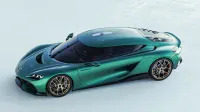Koenigsegg Gemera goes V8-only due to low take-rate for three-cylinder

It’s been more than four years since Koenigsegg debuted the Jesko and Gemera just ahead of the 2020 Geneva Motor Show. The Gemera was the first home for a few of Koenigsegg’s pet projects, a hybrid powertrain based around a twin-turbocharged 2.0-liter three-cylinder dubbed the Tiny Friendly Giant (TFG). The engine featured cam-less Freevalve technology and was assisted by three electric motors. The Swedes claimed a combined 1,676 horsepower and 2,581 pound-feet of torque — 592 horses and 443 twists from the TFG — and a zero-to-62-mph sprint in 1.9 seconds. Those three e-motors, one on the crankshaft and two at the rear, helped deliver all-wheel drive, all-wheel torque vectoring, and all-wheel steering.
And it’s all gone. Not the Gemera, but the Tiny Friendly Giant. Two years after the Gemera appeared, Christian announced that the automaker found a way to fit the Jesko’s twin-turbocharged 5.0-liter V8 into the Gemera’s tighter bay. Once that happened, Koenigsegg said most customers switched to the V8 — reportedly a $400,000 option. “There were so few left that asked for a three-cylinder,” he said, “we managed to convince almost all of them [to go for the V8 instead]. So for the time being, it [the Gemera] is V8 only.
We could frame this as conservative buyers rejecting ingenious novelty, but that wouldn’t be true. This is buyers giving up one ingenious novelty for another ingenious novelty with more familiar bragging rights. See, to get the Jesko’s V8 to work, Koenigsegg engineers redesigned the castings, heads, intake, exhaust, and sump. They shelved the direct-drive transmission from the Regera they’d originally fitted, and created what they call the Light Speed Tourbillon Transmission (LSTT). This was an evolution of the nine-speed direct-drive Light Speed Transmission developed for the Jesko, but smaller, lighter, better. Then the whitecoats created a new six-phase e-motor to replace the original trio of three-phase Quark e-motors that had been paired with the TFG. This one motor to rule them all is called Dark Matter, designed as a blend of radial flux and axial flux topologies called “raxial.”
In the original powertrain, two of the Quark motors on the rear axle could each make a maximum 500 horsepower and 738 pound-feet of torque, the third Quark on the crankshaft made 400 hp and 369 lb-ft. Their combined output when working together rang in at 1,100 hp.
The Dark Matter makes 800 hp and 922 lb-ft. Pairing a single Dark Matter with the LSTT makes the TFG powertrain lighter and smaller again, after the transmission gains, further improving acceleration and performance. New control logic means the Dark Matter can drive the Gemera on its own, the TFG can power the car, or both can be called to action. And the fastback sedan retains its all-wheel drive, four-wheel steering, and four-wheel torque vectoring.
With the hybridized V8, final output comes to 2,268 hp and 2,028 lb-ft. of torque — 600 more horses but 553 fewer torques than with the TFG. So we can’t be mad at buyers.
We would love to see Koenigsegg fit two Gemeras with these respective powertrains to gauge performance. One day, it might happen, Christian telling TG the TFG tech “is still interesting, we’re still working on it…. We might eventually do it in the Gemera one day in some version, but it just took over with the V8. I understand that.”




